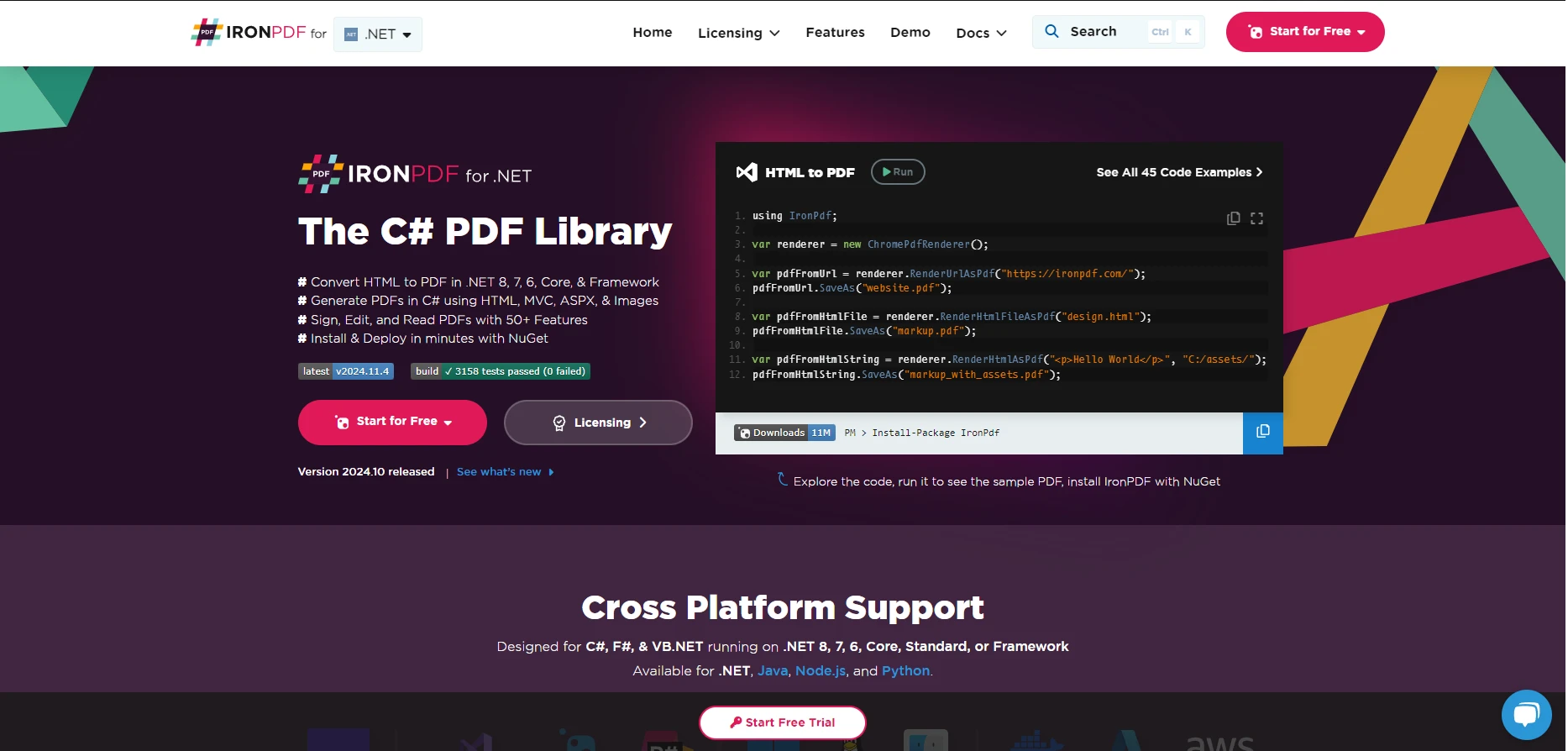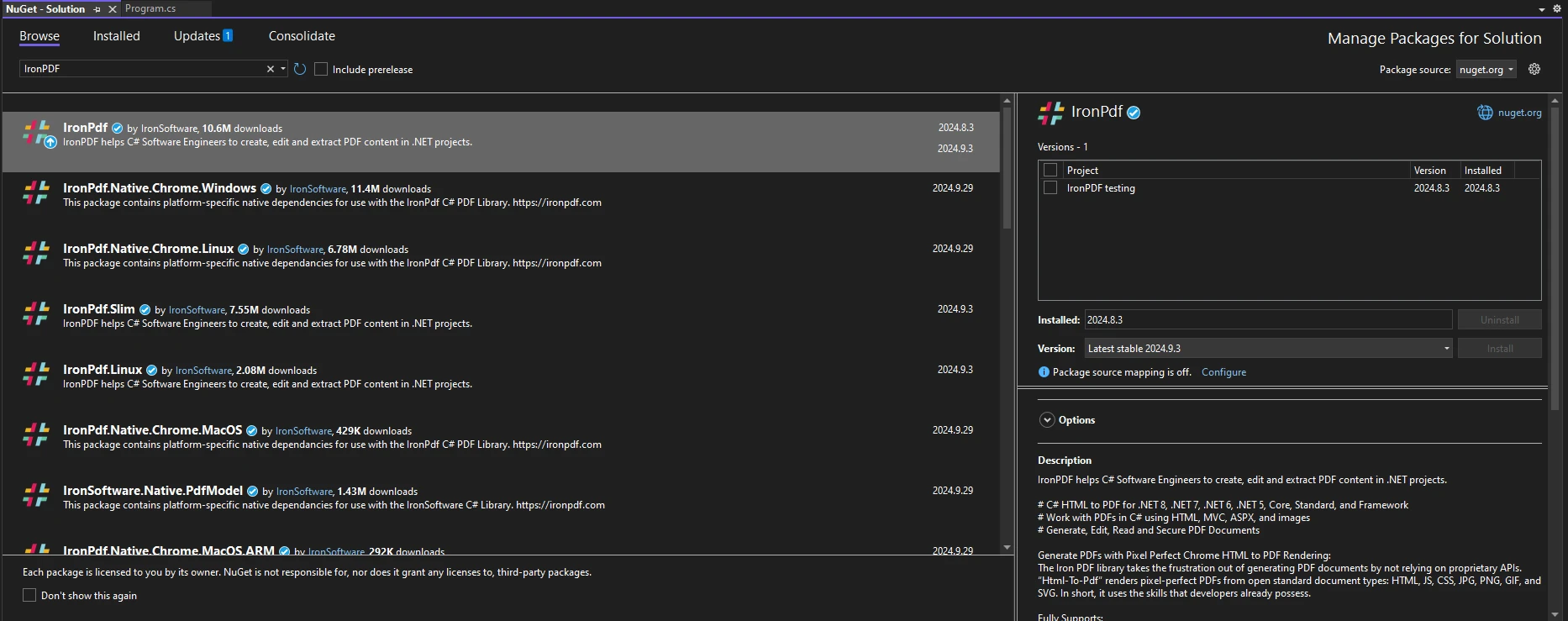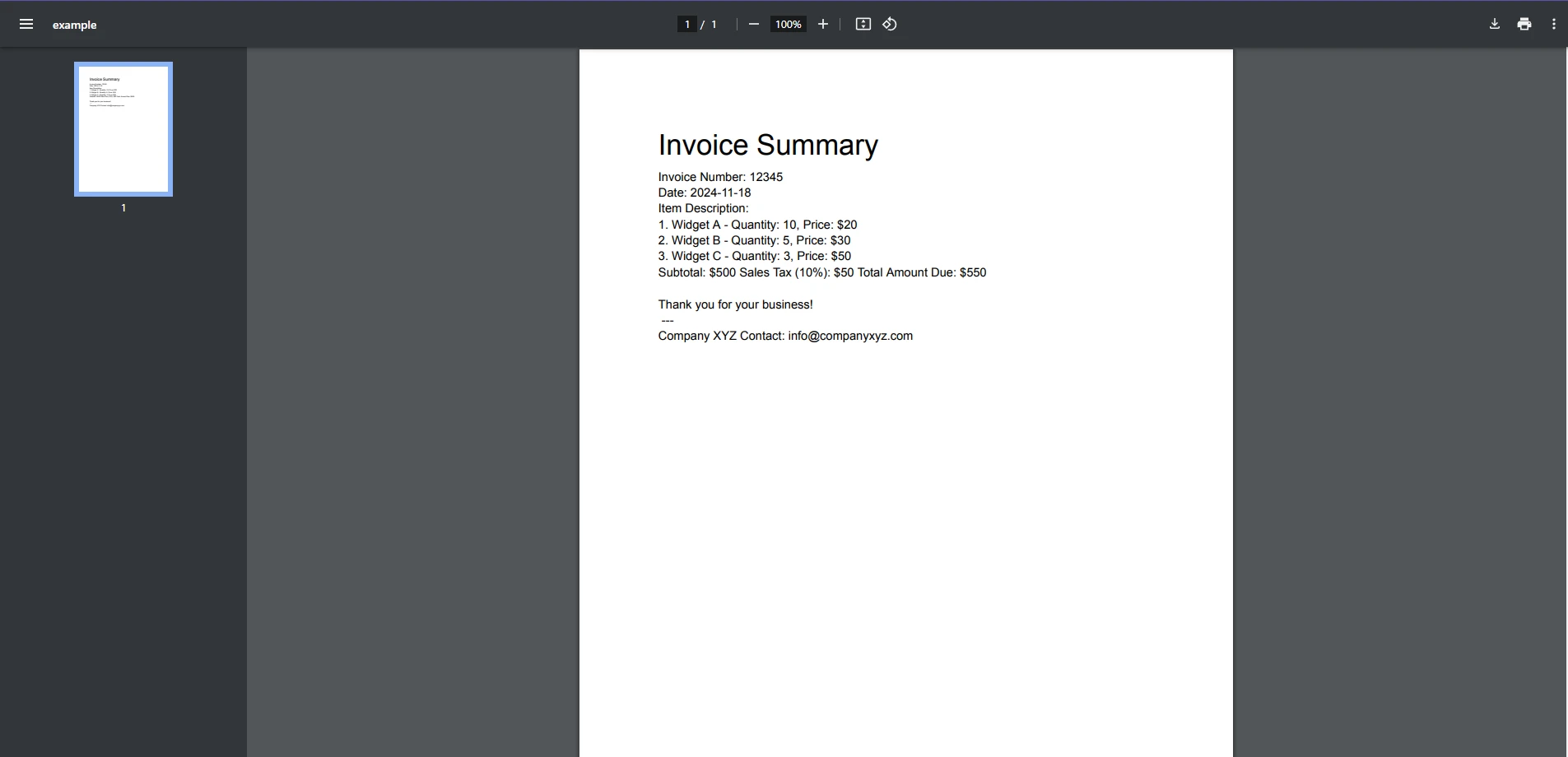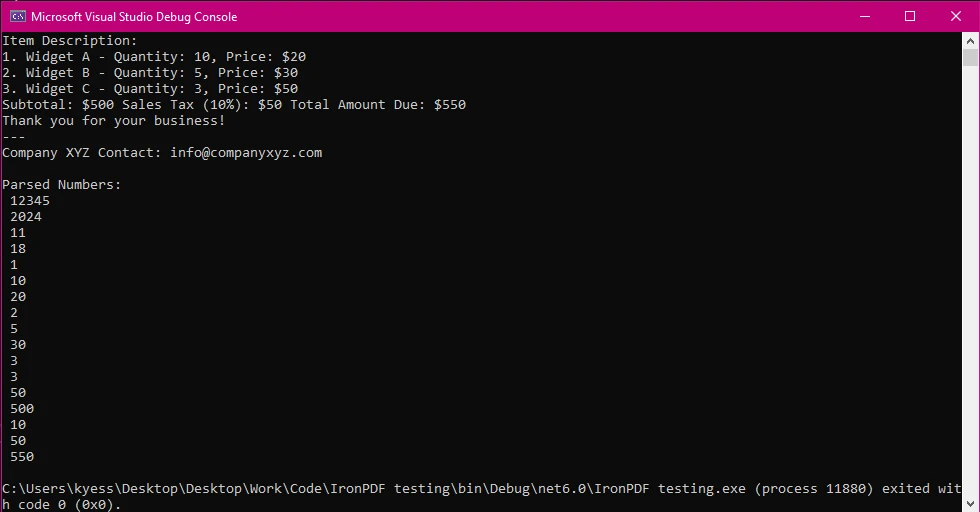Test in production without watermarks.
Works wherever you need it to.
Get 30 days of fully functional product.
Have it up and running in minutes.
Full access to our support engineering team during your product trial
When working with data in C#, developers frequently need to convert textual representations of numbers into integers. This task, known as "parsing integers," is critical for various applications, from processing user input to extracting data from files like PDFs. While C# provides powerful methods for parsing integers, the process can become more complex when working with unstructured or semi-structured data, such as that found in PDFs.
This is where IronPDF, a robust PDF library for .NET developers, comes into play. With IronPDF, you can extract text from PDFs and leverage C#’s parsing capabilities to transform this text into usable numeric data. Whether you're analyzing invoices, reports, or forms, combining C#’s parsing tools with IronPDF simplifies handling PDF data, allowing you to convert string formatted numbers into integers.
In this article, we’ll dive into how ParseInt is used in C# to convert string representations of numbers into integers, and how IronPDF can streamline the process of extracting and parsing numeric data from PDFs.
In C#, converting a string value (such as "123") to an integer is commonly done using int.Parse() or Convert.ToInt32(). These methods help developers transform textual data into usable numeric values for computations and validations.
Here's an example of converting strings using int.Parse():
string numberString = "123";
int num = int.Parse(numberString);
Console.WriteLine(num); // Output: 123string numberString = "123";
int num = int.Parse(numberString);
Console.WriteLine(num); // Output: 123Dim numberString As String = "123"
Dim num As Integer = Integer.Parse(numberString)
Console.WriteLine(num) ' Output: 123Alternatively, using the Convert class:
string numericString = "123";
int i = Convert.ToInt32(numericString);
Console.WriteLine(result); // Outputs: 123string numericString = "123";
int i = Convert.ToInt32(numericString);
Console.WriteLine(result); // Outputs: 123Dim numericString As String = "123"
Dim i As Integer = Convert.ToInt32(numericString)
Console.WriteLine(result) ' Outputs: 123The Convert class allows you to convert strings and other data types safely. It is especially useful when the string variable might represent a null or invalid value, as Convert.ToInt32() returns a default value (0 in this case) instead of throwing an exception.
One issue developers often face when converting strings to integers is dealing with invalid or non-numeric inputs. If the string representation of the number is not in the correct format, methods like int.Parse() will throw an exception. However, Convert.ToInt32() has a built-in fallback mechanism for invalid strings.
Here's an example demonstrating how to handle default values when parsing:
string invalidString = "abc";
int result = Convert.ToInt32(invalidString); // Returns 0 (default value) instead of throwing an error.
Console.WriteLine(result); // Outputs: 0string invalidString = "abc";
int result = Convert.ToInt32(invalidString); // Returns 0 (default value) instead of throwing an error.
Console.WriteLine(result); // Outputs: 0Dim invalidString As String = "abc"
Dim result As Integer = Convert.ToInt32(invalidString) ' Returns 0 (default value) instead of throwing an error.
Console.WriteLine(result) ' Outputs: 0If you want to convert strings with more control, you can use int.TryParse(), which returns a boolean value indicating whether the conversion was successful or not:
string invalidInput = "abc";
if (int.TryParse(invalidInput, out int result))
{
Console.WriteLine(result);
}
else
{
Console.WriteLine("Parsing failed.");
}string invalidInput = "abc";
if (int.TryParse(invalidInput, out int result))
{
Console.WriteLine(result);
}
else
{
Console.WriteLine("Parsing failed.");
}Dim invalidInput As String = "abc"
Dim result As Integer
If Integer.TryParse(invalidInput, result) Then
Console.WriteLine(result)
Else
Console.WriteLine("Parsing failed.")
End IfIn this case, TryParse() uses an out parameter to store the converted integer, which allows the method to return a value without throwing an exception, if the conversion failed then the else statement will run, instead of simply crashing your program. Otherwise, the program will display the result of the successfully parsed number from the input string. Using int.TryParse can be helpful in cases where conversion fails could be expect and you want to avoid the program crashing.

When working with PDFs, you may encounter tables or unstructured text that contains numeric data in string values. To extract and process this data, converting strings to integers is crucial. IronPDF makes this process straightforward, offering both the flexibility and power to read PDF content and perform operations like converting strings to numeric values.
Here are some of the key features IronPDF offers:
To start using IronPDF, you will first need to install it. If it's already installed, then you can skip to the next section, otherwise, the following steps cover how to install the IronPDF library.
To install IronPDF using the NuGet Package Manager Console, open Visual Studio and navigate to the Package Manager Console. Then run the following command:
Install-Package IronPdfInstall-Package IronPdf'INSTANT VB TODO TASK: The following line uses invalid syntax:
'Install-Package IronPdfOpening Visual Studio, go to "tools -> NuGet Package Manager -> Manage NuGet Packages for Solution" and search for IronPDF. From here, all you need to do is select your project and click "Install" and IronPDF will be added to your project.

Once you have installed IronPDF, all you need to add to start using IronPDF is the correct using statement at the top of your code:
using IronPdf;using IronPdf;Imports IronPdfIronPDF offers a free trial with full access to its features. Visit the IronPDF website to download the trial and start integrating advanced PDF handling into your .NET projects.
The following C# code demonstrates how to use IronPDF to extract text from a PDF, then use regular expressions to find and parse all numeric values in the extracted text. The code handles both integers and decimal numbers, cleaning up non-numeric characters like currency symbols.
using IronPdf;
using System.Text.RegularExpressions;
public class Program
{
public static void Main(string[] args)
{
// Load a PDF file
PdfDocument pdf = PdfDocument.FromFile("example.pdf");
// Extract all text from the PDF
string text = pdf.ExtractAllText();
// Print the extracted text (for reference)
Console.WriteLine("Extracted Text: ");
Console.WriteLine(text);
// Parse and print all numbers found in the extracted text
Console.WriteLine("\nParsed Numbers:");
// Use regular expression to find all number patterns, including integers and decimals
var numberMatches = Regex.Matches(text, @"\d+(\.\d+)?");
// Iterate through all matched numbers and print them
foreach (Match match in numberMatches)
{
// Print each matched number
Console.WriteLine($"{match.Value}");
}
}
}using IronPdf;
using System.Text.RegularExpressions;
public class Program
{
public static void Main(string[] args)
{
// Load a PDF file
PdfDocument pdf = PdfDocument.FromFile("example.pdf");
// Extract all text from the PDF
string text = pdf.ExtractAllText();
// Print the extracted text (for reference)
Console.WriteLine("Extracted Text: ");
Console.WriteLine(text);
// Parse and print all numbers found in the extracted text
Console.WriteLine("\nParsed Numbers:");
// Use regular expression to find all number patterns, including integers and decimals
var numberMatches = Regex.Matches(text, @"\d+(\.\d+)?");
// Iterate through all matched numbers and print them
foreach (Match match in numberMatches)
{
// Print each matched number
Console.WriteLine($"{match.Value}");
}
}
}Imports Microsoft.VisualBasic
Imports IronPdf
Imports System.Text.RegularExpressions
Public Class Program
Public Shared Sub Main(ByVal args() As String)
' Load a PDF file
Dim pdf As PdfDocument = PdfDocument.FromFile("example.pdf")
' Extract all text from the PDF
Dim text As String = pdf.ExtractAllText()
' Print the extracted text (for reference)
Console.WriteLine("Extracted Text: ")
Console.WriteLine(text)
' Parse and print all numbers found in the extracted text
Console.WriteLine(vbLf & "Parsed Numbers:")
' Use regular expression to find all number patterns, including integers and decimals
Dim numberMatches = Regex.Matches(text, "\d+(\.\d+)?")
' Iterate through all matched numbers and print them
For Each match As Match In numberMatches
' Print each matched number
Console.WriteLine($"{match.Value}")
Next match
End Sub
End Class

Extract Text from PDF:
The code starts by loading a PDF file using IronPDF. It then extracts all the text from the PDF.
Use Regular Expressions to Find Numbers:
The code uses a regular expression (a pattern to match text) to search through the extracted text and find any numbers. The regular expression looks for both whole numbers (e.g., 12345) and decimal numbers (e.g., 50.75).
Parse and Print Numbers:
Once the numbers are found, the program prints each one to the console. This includes integers and decimals.
Why Regular Expressions:
Regular expressions are used because they are powerful tools for finding patterns in text, like numbers. They can handle numbers with symbols (like currency symbols $), making the process more flexible.
Extracting clean data from complex PDF structures often results in string values that may require further processing, such as converting strings into integers. Here are some common challenges and how IronPDF can help:
PDFs often contain numbers formatted as text (e.g., "1,234.56" or "12,345 USD"). To process these correctly, you need to ensure that the string representation of the number is in the correct format for parsing. IronPDF allows you to extract text cleanly, and you can use string manipulation methods (e.g., Replace()) to adjust formatting before conversion.
Example:
string formattedNumber = "1,234.56"; // String value with commas
string cleanNumber = formattedNumber.Replace(",", ""); // Remove commas
int result = Convert.ToInt32(Convert.ToDouble(cleanNumber)); // Convert to integer
Console.WriteLine(result); // Outputs: 1234string formattedNumber = "1,234.56"; // String value with commas
string cleanNumber = formattedNumber.Replace(",", ""); // Remove commas
int result = Convert.ToInt32(Convert.ToDouble(cleanNumber)); // Convert to integer
Console.WriteLine(result); // Outputs: 1234Dim formattedNumber As String = "1,234.56" ' String value with commas
Dim cleanNumber As String = formattedNumber.Replace(",", "") ' Remove commas
Dim result As Integer = Convert.ToInt32(Convert.ToDouble(cleanNumber)) ' Convert to integer
Console.WriteLine(result) ' Outputs: 1234In a complex PDF, numeric values may appear in different formats or scattered across different locations. With IronPDF, you can extract all the text and then use regular expressions to find and convert strings into integers efficiently.
Parsing integers in C# is an essential skill for developers, especially when dealing with user input or data extraction from various sources. While built-in methods like int.Parse() and Convert.ToInt32() are useful, handling unstructured or semi-structured data—such as the text found in PDFs—can present additional challenges. This is where IronPDF comes into play, offering a powerful and straightforward solution for extracting text from PDFs and working with it in .NET applications.
By using IronPDF, you gain the ability to easily extract text from complex PDFs, including scanned documents, and convert that data into usable numeric values. With features like OCR for scanned PDFs and robust text extraction tools, IronPDF allows you to streamline data processing, even in challenging formats.
Whether you're dealing with invoices, financial reports, or any other document containing numeric data, combining C#'s ParseInt methods with IronPDF will help you work more efficiently and accurately.
Don't let complex PDFs slow down your development process—start using IronPDF is the perfect opportunity to explore how IronPDF can enhance your workflow, so why not give it a try and see how it can streamline your next project?